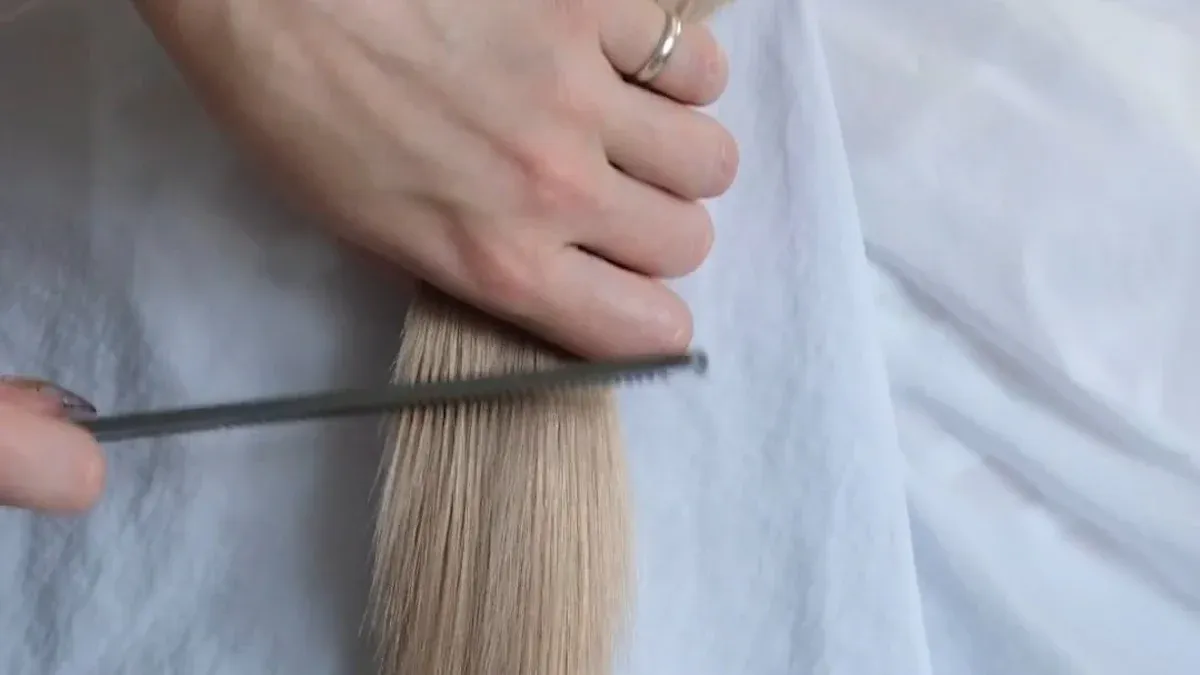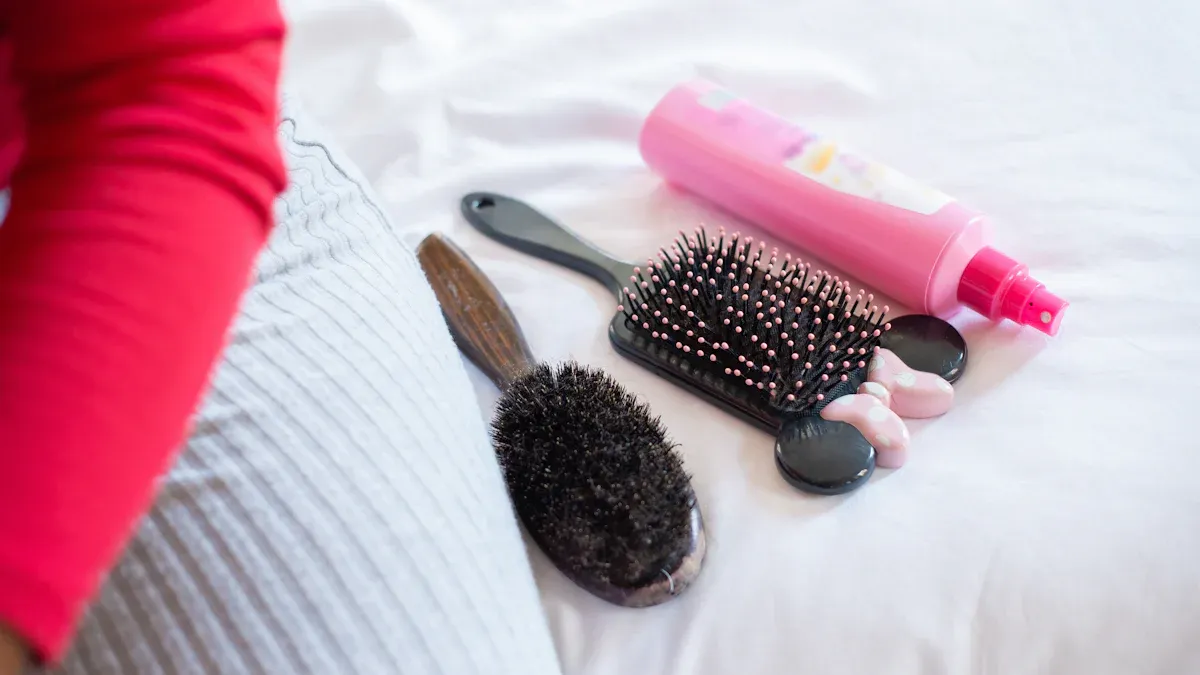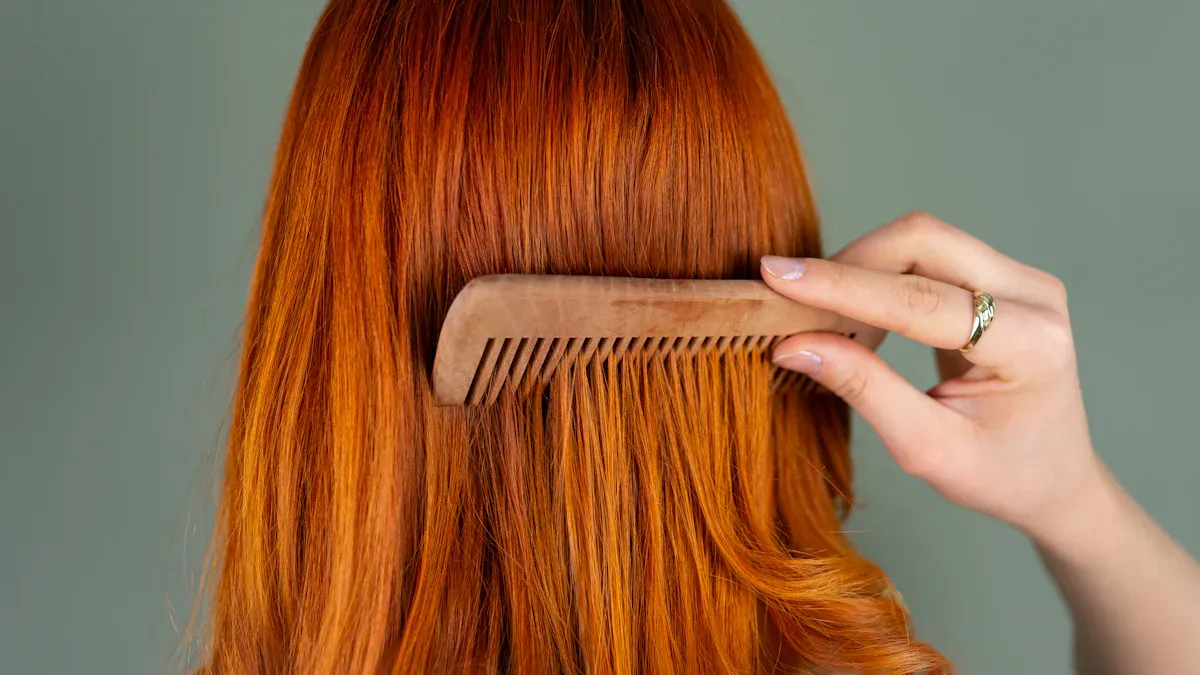
How to Pick the Perfect Wig Brush for Your Wig Type
Share

Looking for the best wig brush for your wig? You need the right kind of wig brush for each style—curly, straight, synthetic, or human hair. Using the right wig styling brush keeps your wig looking smooth and helps it last longer. A paddle brush works great for straight wigs, while special brushes help with curls. For great wig care, remember these tips:
Regular brushing keeps your wig smooth and stops tangles.
Always brush from the bottom up to avoid breakage.
Only brush your wig when it’s dry.
Finding the perfect brush makes wig care easy and keeps your hair looking fresh.
Key Takeaways
Choose the right wig brush for your wig type to keep it looking fresh and stylish.
Always brush from the ends to the roots to prevent breakage and tangles.
Use a wide-tooth comb for detangling and avoid regular hairbrushes to protect your wig.
For curly wigs, use a detangling brush or wide-tooth comb to maintain bounce and prevent frizz.
Regular brushing helps extend the life of your wig and keeps it smooth and tangle-free.
Best Wig Brush by Type
Choosing the right wig brush can make a huge difference in how your wig looks and feels. Each wig type needs a special touch. Let’s break down the best wig brush for each style so you can keep your wig looking its best.
Human Hair Wig Brush
Human hair wigs feel soft and natural, but they need gentle care. You want a wig brush that detangles without pulling or causing frizz. Many people love using a boar bristle brush or a paddle brush for these wigs. These types of wig brushes help spread natural oils and keep the hair shiny.
The Red By Kiss Square Wig Brush stands out for detangling without causing frizz. It works well for both human hair wigs and synthetic wigs.
Boar bristle brushes gently glide through strands and help prevent breakage.
Paddle brushes cover more area and work well for longer wigs.
Tip: Always start brushing at the ends and work your way up. This keeps your wig smooth and helps you avoid damage.
If you want to minimize static, look for a wig brush with natural bristles. These brushes help keep hair smooth and shiny. You can find good options in every price range, so you don’t have to spend a lot to get the best wig brush for your human hair wigs.
Synthetic Wig Brush
Synthetic wigs need a different kind of care. These wigs can tangle easily, and using the wrong brush can cause frizz and static. The best wig brush for synthetic wigs is usually a loop brush or a wide-tooth comb. These types of wig brushes glide through fibers without pulling or breaking them.
Loop brushes have flexible bristles that move with the hair, making them gentle on synthetic wigs.
Wide-tooth combs help you detangle without causing bushy ends or static.
If you use a regular bristle brush, you might notice your wig gets frizzy or loses its shine. Some people have used a wide-bristle brush on synthetic wigs and ended up with tangles and bushy ends after just a month. This means you might need to replace your wig more often.
Note: To keep your synthetic wig looking new, avoid nylon bristle brushes. They can break the fibers and cause static.
You can find a good wig brush for synthetic wigs at many beauty stores. Prices vary, but you don’t need the most expensive brush to get great results.
Curly and Wavy Wig Brush
Curly and wavy wigs need extra care to keep their shape and bounce. The best wig brush for these styles is one that detangles without ruining the curls. Paddle brushes, wide-tooth combs, and detangling brushes work well for curly and wavy wigs.
Paddle brushes have wide, flat bristles that reduce static and breakage.
Wide-tooth combs are gentle and perfect for detangling wet hair.
Detangling brushes have flexible bristles that glide through knots and add shine.
Boar bristle brushes help distribute oils and keep curls shiny.
Vented brushes speed up drying and help reduce frizz.
Tip: Never brush curly or wavy wigs when they are dry. Use a detangling spray or a little water to help the wig brush move smoothly.
These types of wig brushes help you keep your curls defined and prevent frizz. You can find affordable options, so you don’t have to break the bank to care for your curly or wavy wig.
Straight Wig Brush
Straight wigs look sleek and smooth, but they can get static or breakage if you use the wrong wig brush. The best wig brush for straight wigs is a paddle brush or a wide-tooth comb. These types of wig brushes help you detangle and smooth the hair without causing static.
Tangle Teezer brushes work well for straight wigs. They detangle with minimal breakage and help reduce static.
Wide-tooth combs are gentle and help control static when used the right way.
Avoid nylon bristle brushes. They can break synthetic hair and make static worse.
Note: If you want to keep your straight wig looking shiny, use a wig brush with soft bristles and avoid brushing too hard.
You can find the best wig brush for straight wigs in many price ranges. Look for one that feels comfortable in your hand and glides through the hair easily.
When you pick the right wig brush for your wig type, you help your wig last longer and look better. Try different types of wig brushes to see which one works best for you. Remember, gentle brushing and the right tools make all the difference!
Why the Right Wig Brush Matters
Choosing the right wig brush does more than just make your wig look nice. It helps you keep your wig healthy, stylish, and long-lasting. Let’s look at why your brush choice matters so much.
Preventing Damage
You want your wig to stay smooth and tangle-free. The wrong wig brush can pull, snag, or even break the hair. This can make your wig look old fast. When you use the right wig brush, you protect each strand and keep your wig looking fresh.
A wide-tooth comb or vented wig brush glides through wig strands. These tools do not pull or cause shedding.
Gentle brushing stops split ends and keeps the hair from breaking.
You avoid frizz and keep the wig soft.
Using the right wig brush means less damage and more good hair days.
Maintaining Style
A good wig brush helps you keep your style looking sharp. If you have curls, waves, or straight hair, the right brush keeps the shape and bounce. You can use a paddle brush for straight wigs or a detangling brush for curly styles. This way, your wig always looks the way you want.
The right wig brush keeps curls defined and stops them from getting frizzy.
For straight wigs, a paddle brush keeps the hair sleek and smooth.
You spend less time fixing your wig and more time enjoying your look.
Extending Wig Life
When you care for your wig with the right wig brush, you help it last longer. You do not have to buy a new wig as often. Brushing gently and using the right tool keeps the hair strong and shiny. Your wig stays beautiful for months, sometimes even years.
A little care with the right wig brush goes a long way. You save money and always look your best.
Wig Brush Types Explained

Wide-Tooth Comb
A wide-tooth comb is a must-have for every wig owner. You can use this tool to gently work through tangles without pulling or breaking the hair. Wide-tooth combs work better than most other brushes when you need to detangle your wig. The spaces between the teeth let you glide through knots with less effort. Many people like the Bamboo Detangle Comb because it helps you style your wig with almost no damage.
If you want to keep your wig looking smooth and healthy, reach for a wide-tooth comb first.
Pros:
Great for detangling
Reduces breakage
Easy to use on wet or dry wigs
Cons:
Not the best for smoothing or styling
May not define curls
Best for: All wig types, especially curly or tangled wigs
Bristle Brush
A bristle brush can help you smooth and style your wig. You will find two main types: synthetic bristles and boar bristles. Boar bristle brushes spread oils and add shine to human hair wigs. Synthetic bristles work well for smoothing straight wigs. You should use gentle strokes to avoid pulling out hair.
Pros:
Smooths hair
Adds shine
Good for finishing styles
Cons:
Can cause static on synthetic wigs
May pull on tight curls
Best for: Human hair wigs, straight wigs
Loop Brush
A loop brush looks different from other brushes. The bristles form loops instead of straight lines. This design lets you brush your wig without snagging or pulling on the fibers. You can use a loop brush on both synthetic and human hair wigs. It works well for daily care and helps keep your wig brush gentle.
Pros:
Gentle on fibers
Prevents shedding
Works for all wig types
Cons:
Not great for heavy tangles
May not style as well as other brushes
Best for: Synthetic wigs, daily brushing
Detangling Brush
A detangling brush makes wig care easy, especially if you have curly or synthetic wigs. The bristles are spaced out and flexible, so they glide through hair and reduce pulling. You will notice less breakage and pain when you use this wig brush. The soft tips protect your wig and keep it looking fresh.
Widely spaced bristles glide through hair easily
Works for both human hair and synthetic wigs
Perfect for curly, kinky, or tangled wigs
If your wig tangles often, a detangling brush can save you time and keep your style looking great.
Pros:
Quick and easy detangling
Gentle on hair
Good for complex styles
Cons:
Not ideal for smoothing
May not add shine
Best for: Curly wigs, synthetic wigs, wigs that tangle easily
How to Brush a Wig

Step-by-Step Guide
Brushing your wig the right way keeps it looking fresh and helps it last longer. Here’s a simple guide you can follow every time you reach for your wig brush:
Place your wig on a wig stand or hold it gently.
Make sure the hair is dry before you start.
Use a wide-tooth comb or a wig brush designed for wigs.
Begin at the ends and slowly detangle small sections.
Work your way up toward the roots, being gentle with each stroke.
If you hit a knot, don’t pull hard. Use your fingers or the comb to loosen it.
Finish by smoothing the hair with your wig brush for a polished look.
Tip: Always brush gently. Rushing or using too much force can damage your wig and make it shed.
Tips for Each Wig Type
Every wig needs a special touch. Here are some easy tips for brushing different styles:
Human Hair Wigs: Use a wig brush with soft bristles or a wide-tooth comb. Start at the ends and detangle slowly. This keeps the hair smooth and shiny.
Synthetic Wigs: Pick a loop brush or wide-tooth comb. Brush gently to avoid frizz. Never use high heat or regular hair products.
Curly Wigs: Use your fingers or a wide-tooth comb to detangle. Avoid wig brushes because they can separate curls and cause frizz. Curly synthetic wigs need less work, but curly human hair wigs need more care to keep curls intact.
Straight Wigs: Use a paddle wig brush or wide-tooth comb. Brush from the ends up and keep strokes gentle to prevent breakage.
Note: If your wig tangles often, try a detangling spray before you use your wig brush.
Mistakes to Avoid
Brushing mistakes can ruin your wig. Here’s what you should watch out for:
Starting at the roots instead of the ends can make tangles worse.
Using a regular hairbrush instead of a wig brush can cause shedding and damage.
Brushing wet hair can stretch and break wig fibers.
Using high heat tools or regular hair products can harm your wig.
Brushing too hard or too fast can pull out hair and create frizz.
Remember: Take your time and use the right wig brush. Your wig will thank you with smooth, shiny hair every day!
Wig Brush Chart
Quick Reference by Wig Type
You want to pick the right wig brush for your wig, but all the choices can feel confusing. Here’s a quick chart to help you match your wig brush to your wig type. Just check the table below and see which brush works best for your style.
Wig Type |
Best Wig Brush |
Why It Works Well |
|---|---|---|
Straight |
Paddle, Tangle Teezer |
Smooths hair, reduces static |
Curly/Wavy |
Wide-Tooth Comb, Detangling Brush |
Keeps curls, prevents frizz |
Human Hair |
Boar Bristle, Paddle |
Adds shine, gentle on strands |
Synthetic |
Loop Brush, Wide-Tooth Comb |
Prevents breakage, gentle on fibers |
High Coil (4A-4C) |
Handles tight coils, reduces tangles |
Tip: Always start with a wide-tooth comb if your wig has lots of tangles. This helps you avoid damage before you use your main wig brush.
Pros and Cons Overview
You want to know what makes each wig brush special. Here’s a simple table that shows the pros and cons of some popular brushes. This way, you can pick the one that fits your wig and your needs.
Wig Brush Name |
Pros |
Cons |
|---|---|---|
Works for wigs and extensions, firm bristles |
No major cons |
|
Tangle Teezer |
Great for fine or straight hair |
Not good for tight coils (4B/4C) |
FHI Heat Unbrush |
Easy to clean, gets the job done |
Could be bigger, bristles less firm |
If you have a straight wig, the Tangle Teezer makes brushing easy and smooth.
For curly or coily wigs, you might want to try a wig brush like Olivia Garden or a design made for high coils.
The FHI Heat Unbrush is easy to clean, so you spend less time on wig care.
Remember, the best wig brush for your wig depends on your hair type and how you want your wig to look. Try a few and see which one feels right for you!
Choosing the right wig brush for your wig makes a big difference. You keep your wig looking fresh and help it last longer. The quick chart above helps you pick the best brush fast. When you use the right brush, you prevent tangles, keep your style, and reduce shedding. Regular brushing also makes wig care simple. Remember, a little care goes a long way—your wig will thank you!
FAQ
How often should you brush your wig?
You should brush your wig every day if you wear it often. If you wear it less, brush it before and after each use. This keeps your wig smooth and tangle-free.
Can you use a regular hairbrush on a wig?
No, you should not use a regular hairbrush. Wig brushes have special bristles that protect wig fibers. Regular brushes can pull, break, or frizz your wig.
What should you do if your wig gets very tangled?
Start with a wide-tooth comb. Work on small sections from the ends up. Use a detangling spray if needed. > Tip: Never pull hard. Take your time to avoid damage.
Do you need a different brush for curly wigs?
Yes! Curly wigs need a wide-tooth comb or a detangling brush. These tools keep curls bouncy and stop frizz. Avoid brushes that separate curls.
